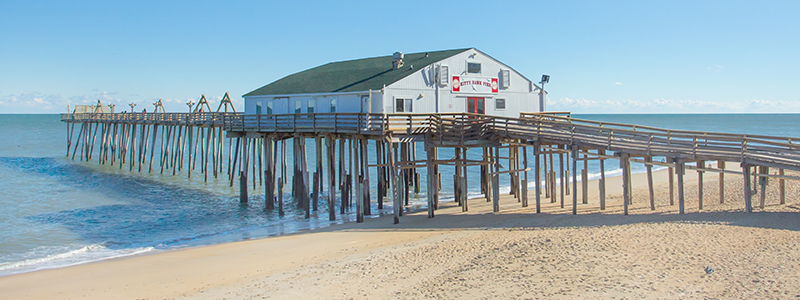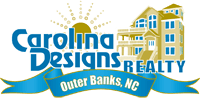The towns of the Outer Banks have very distinctive names. Mostly there’s nothing at all that sounds like a Norfolk, or Virginia Beach, or Philadelphia. Really not much at all in the way of typical European-sounding names.
Those distinctive sounding names are a window into the history of the Outer Banks and maybe says a little bit about the history of our nation and the role the Post Office played in knitting everything together.
We’ve organized the towns and villages of the Outer Banks from north to south, with just a little bit of the story of how they got their names.
Carova

Properly speaking, Carova is the village at the north end of the Currituck Banks on the border with Virginia. The name is a shortened version of Carolina (Caro) and Virginia (VA).
In general use, however, everything north of where the NC 12 pavement ends—the 4WD area—is called Carova. Historically there were small communities in the Carova area, including Wash Woods, Penny’s Hill, and Seagull.
Corolla

By the late 19th century, with the Currituck Beach Lighthouse fully staffed and the Jones Hill Lifesaving station at the lighthouse, there was a small but stable population at what is now the village of Corolla.
In 1895 the Postal Service asked local residents to come up with a name.
The locals knew the area as Jones Hill, but the name was rejected, although no one knows why. Currituck Beach was rejected because the Currituck Post Office was on the mainland. The name of the petal of a flower was put forward, probably in the hope it would make the area seems more enticing, and Corolla had its own post office.
Duck

In 1910 Lloyd Toler decided he wanted the cluster of homes on the Currituck Sound north of Kitty Hawk to have a post office…and he put his name forward as postmaster. USPS agreed to the post office and his employment, but they needed a name.
Toler looked around and suggested the new post office be named after the area’s most plentiful product—Duck.
Southern Shores
Frank Stick purchased 2600 acres of barren sand dunes, swamp, and maritime forest north of Kitty Hawk in 1947. His plan called for developing the four square miles into a resort community, and he wanted to suggest warm sunshine and soft sand.
The word north couldn’t be part of the name. Since it was on the shore, why not Southern Shores?
Kitty Hawk

The most likely source for the naming of Kitty Hawk comes from the Algonquin word Chickehauk which seems to have been a Native American village in the area. There is a possibility that Kitty Hawk evolved from the local description for hunting geese, reported to be “killy honk.”
There are other more colorful explanations as well. Anyone who has been attacked by swarms of aggressive mosquitos in our area will appreciate the explanation that Kitty Hawk was derived from the phrase Skeeter Hawk. Another belief is that Kitty Hawk evolved from the words keel hauls, an area term used to describe large hunting hauls.
What we do know as fact is that in the early 1700s, this region was listed as Chickehawk on area maps, and by the end of the century was recorded on deeds as Kittyhuk or Kitty Hawk.
Kill Devil Hill
Subject to multiple levels of conjecture, no one can state with certainty the origin of the name Kill Devil Hills. Taking in the sweep of history and personal antipathy of one human being, there is the possibility that the name came from a description that William Byrd of Virginia hung on the area.
To say Virginian William Byrd, who surveyed the dividing line between Virginia and North Carolina, disliked the residents of the state would be an understatement. Among other insults, in an unpublished book, he described them as “. . . indolent wretches.” He also wrote that “Most of the Rum they get in this Country . . . is so bad and unwholesome, that it is not improperly called ‘Kill-Devil.”
There is also the retelling of a local sailors’ comment that it was enough to kill the devil to navigate the local waters. Lastly, there is the possibility that the town got its name from the killdeer—a medium-sized plover that is common in the area.
Nags Head

Most early residents of the Outer Banks had no moral objection to helping themselves to the contents of shipwrecks. A myth exists that a lantern was tied around a nag’s head, and the motion of the horse walking back and forth looked like an anchored ship to entice sea captains to shore. That tale, however, is largely discounted.
It is more likely that in the late 18th or early 19th century, someone with ties to England purchased a tract of land where Nags Head is today. Nags Head was a fairly common place name in England, and it is entirely possible that the new landowner named his holdings after his hometown.
There is no town of Nags Head in England today – at least not according to Google Maps. However, almost every hamlet, village, town, and city in Great Britain appears to have at least one Nags Head Pub.
Manteo/Wanchese

Manteo and Wanchese were Native Americans who returned with the English to England in 1584 when the first outpost was established for what would become the Lost Colony. Both were associated with the ruling class of the Indians nations in the area, although it is not clear if they were relatives or the sons of close advisors to the leaders.
Manteo became an ally of the English and helped to smooth over the brutality of Captain Ralph Lane—that’s a story in itself. Wanchese distrusted the English and returned to his people as soon as he returned to Roanoke in 1586.
Rodanthe, Waves, Salvo – The Tri-Villages

The three villages just south of Pea Island National Wildlife Refuge, Rodanthe, Waves, and Salvo, are collectively referred to as the Tri-Villages. Historically though, they were their own distinct villages—more like hamlets—and all three owe their names to the Postal Service.
Locals in what is now known as Rodanthe and Waves called their community Chicamocomico through most of the 19th century. In 1874 the USPS decided the area needed a post office and rejected Chicamocomico out of hand as too hard to spell.
No one is sure why the Post Office chose Rodanthe. There is a nonnative cactus-like plant that may have been what they were thinking of.
By 1939 the Postal Service felt a new post office was needed south of Rodanthe, and newly hired Postmistress Anna Midgette, suggested Waves hoping that it would bring visitors to the area.
How Salvo got its name may be the most interesting of all.
In 1861 Northern forces seized the Confederate forts at Hatteras and Ocracoke. Southern troops were sent to wrest control from the Union.
The Confederate troops marched down Hatteras Island hoping to dislodge the north. The Union navy was lurking off the coast of Hatteras Island to protect against that strategy. On the USS Monticello an officer circled a spot on a map and wrote “salvo” indicating that was where he wanted the shells to land.
The name stuck, and the Postal Service officially changed the name to Salvo from Clark-Betheny in 1901.
Avon
The blame for this one rests solely on the Post Office.
The original name for the area was the Algonquin Indian word Kinakeet meaning a place where people meet. No one seems to know why, but in 1883 the Postal Service decided the name for the village would be Avon.
Interestingly villagers continued to call Avon Kinakeet well into the 20th century, and some of the people who were born and raised on Hatteras Island still call it by that name.
Buxton

Buxton gives further proof of how large a role the Post Office played in naming towns and villages on the Outer Banks.
With the construction of a new state-of-the-art lighthouse, Cape Hatteras Light in 1870, warning mariners away from Diamond Shoals, the community needed a post office. In 1873 the Cape post office was established.
In 1882 the name was changed to Buxton. There are no written records indicating why, but the most likely reason was to honor the efforts of North Carolina Superior Court Judge Ralph P. Buxton during the reconstruction period following the Civil War.
Hatteras
It is unclear where the name Hatteras originated. One theory holds it was derived from an Algonquin word meaning “where there is less vegetation.” Regardless of the original meaning or pronunciation, it clearly was once an American Indian word.
The first reference by Europeans to the word “hatteras” was 1585 when Sir Richard Greenville noted Hatorask Inlet north of what is now called Cape Hatteras. The inlet was placed just north of where Oregon Inlet is today, so there’s a good possibility that was what became known as Roanoke Inlet.
The Postal Service accepted the name from its earlier inception. The name Hatteras has been an official recognized town name since 1856, when a post office was established there.
Ocracoke

Another village name derived from an American Indian word, although again, no one is sure what the original meaning or pronunciation was.
An early version of the name first shows up on a map created by John White, the leader of the failed Lost Colony. At that time he called the inlet south of Ocracoke “Wokokon.” That is what we now call Ocracoke Inlet. A number of different spellings, including Wokokon, Woccocon, and Occacock, were used on maps over the years. Ocracoke as the accepted spelling was established in the later 19th century.
